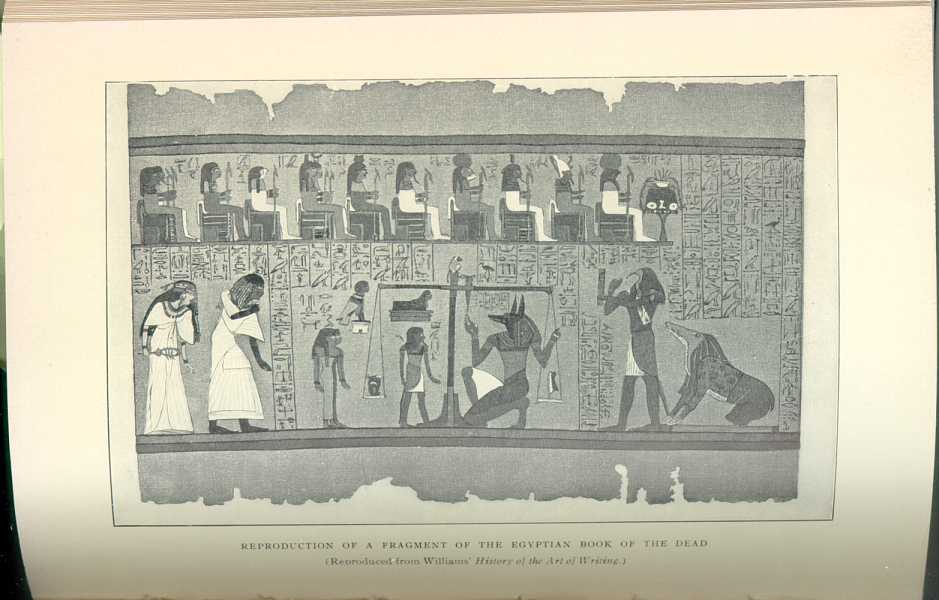| IV THE DEVELOPMENT OF THE ALPHABET A History of Science: in Five Volumes. Volume I: The Beginnings of Science | ||
EGYPTIAN WRITING
Of the two ancient systems of writing just referred to as being in vogue at the so-called dawnings of history, the more picturesque and suggestive was the hieroglyphic system of the Egyptians. This is a curiously conglomerate system of writing, made up in part of symbols reminiscent of the crudest stages of picture-writing, in part of symbols having the phonetic value of syllables, and in part of true alphabetical letters. In a word, the Egyptian writing represents in itself the elements of the various stages through which the art of writing has developed. [39] We must conceive

REPRODUCTION OF A FRAGMENT OF THE EGYPTIAN BOOK OF
THE DEAD
(Reproduced from Williams' History of the Art of
Writing.)
[Description:
Egyptian mural, depicting a central figure with a dog head
kneeling under a set of scales; to his right is a standing figure
with a bird-head, and a kneeling animal figure; to the left are
two smaller figures, and two same-scale femal figures standing
atthe far left. Above are ten figures seated in a row, all
facing right, with hieroglyphic text filling in space throughout.
]
Here, for example, in the midst of unintelligible lines and pot-hooks, are various pictures that are instantly recognizable as representations of hawks, lions, ibises, and the like. It can hardly be questioned that when these pictures were first used calligraphically they were meant to represent the idea of a bird or animal. In other words, the first stage of picture-writing did not go beyond the mere representation of an eagle by the picture of an eagle. But this, obviously, would confine the presentation of ideas within very narrow limits. In due course some inventive genius conceived the thought of symbolizing a picture. To him the outline of an eagle might represent not merely an actual bird, but the thought of strength, of courage, or of swift progress. Such a use of symbols obviously extends the range of utility of a nascent art of writing. Then in due course some wonderful psychologist—or perhaps the joint efforts of many generations of psychologists—made the astounding discovery that the human voice, which seems to flow on in an unbroken stream of endlessly varied modulations and intonations, may really be analyzed into a comparatively limited number of component sounds—into a few hundreds of syllables. That wonderful idea conceived, it was only a matter of time until it would occur to some other enterprising genius that by selecting an arbitrary symbol to represent each one of these elementary sounds it would be possible to make a written record of the words of human speech which
So fond were the Egyptians of their pictorial symbols used ideographically that they clung to them persistently throughout the entire period of Egyptian history. They used symbols as phonetic equivalents very frequently, but they never learned to depend upon them exclusively. The scribe always interspersed his phonetic signs with some other signs intended as graphic aids. After spelling a word out in full, he added a picture, sometimes even two or three pictures, representative of the individual thing, or at least of the type of thing to which the word belongs. Two or three illustrations will make this clear.
Thus qeften, monkey, is spelled out in full, but the picture of a monkey is added as a determinative; second, qenu, cavalry, after being spelled, is made unequivocal by the introduction of a picture of a horse; third, temati, wings, though spelled elaborately, has pictures of wings added; and fourth, tatu, quadrupeds,
It must not be supposed, however, that it was a mere whim which led the Egyptians to the use of this system of determinatives. There was sound reason back of it. It amounted to no more than the expedient we adopt when we spell "to,'' "two,'' or "too,'' in indication of a single sound with three different meanings. The Egyptian language abounds in words having more than one meaning, and in writing these it is obvious that some means of distinction is desirable. The same thing occurs even more frequently in the Chinese language, which is monosyllabic. The Chinese adopt a more clumsy expedient, supplying a different symbol for each of the meanings of a syllable; so that while the actual word-sounds of their speech are only a few hundreds in number, the characters of their written language mount high into the thousands.
| IV THE DEVELOPMENT OF THE ALPHABET A History of Science: in Five Volumes. Volume I: The Beginnings of Science | ||